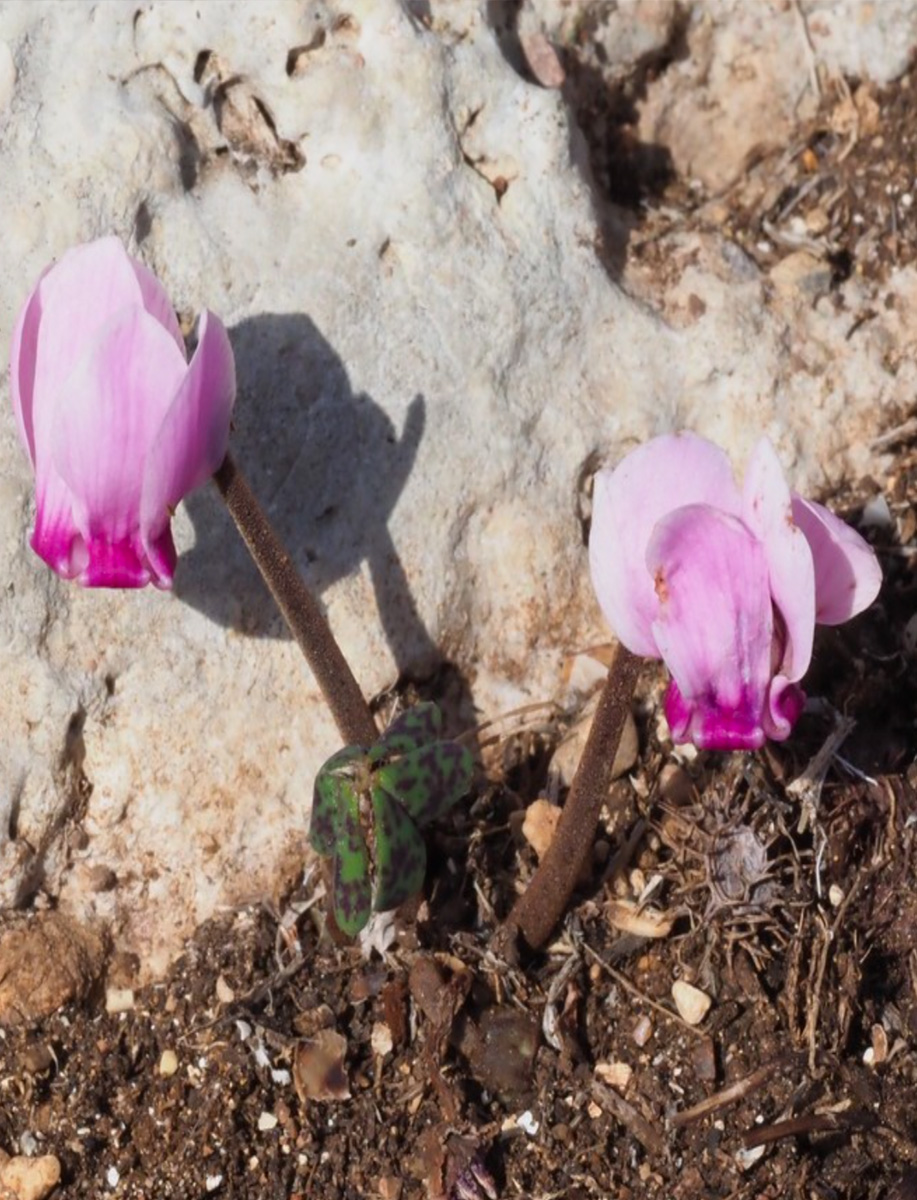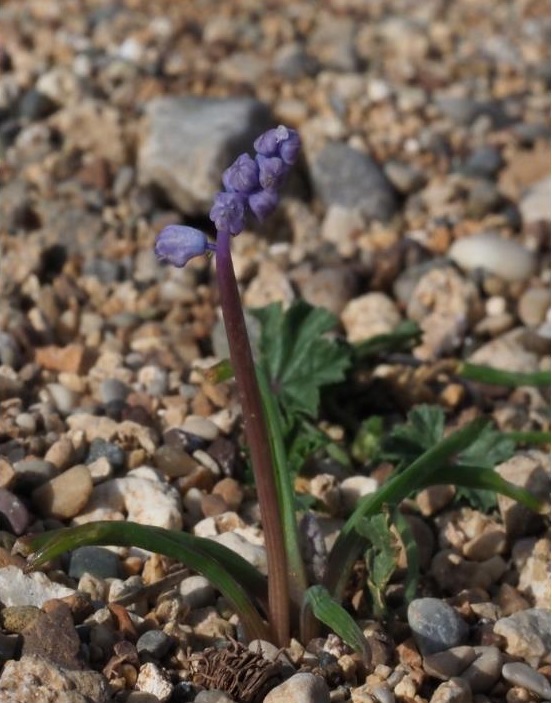Rhodes autumn trip report
1 – 9 November 2023
1st. Arrival and transfers to hotel
2nd. A day in Rhodes town. After an introductory meeting we walked to the medieval city and saw the Palace of the Grand Master of the Knights of Rhodes and then the archaeological museum. After that we walked round the moat, finding a number of plants such as Echium angustifolium, Heliotropium hirsutissimum, Ricinus communis, Vitex agnus-castus, Tribulus terrestris and Hyoscamus albus growing on the walls.


3rd. Our destination this morning was the Akropolis of Rhodes, where we had a number of target plants. Almost straight away we found Cyclamen graecum subsp. anatolicum, flowering profusely. We then found Narcissus serotinus, Thymus capitatus, Plumbago europaea, Reseda alba, and Leontodon tuberosum, all in flower. Further searching down a slope revealed one flowering specimen of Crocus tournefortii.
We then boarded our bus and headed south, down the eastern coast of Rhodes. There were 3 other target plants and we stopped at a number of places and searched but everywhere was very dry and it is likely that flowering has been delayed. However we did find Allium archeotrichon, an interesting autumn-flowering allium, endemic to Rhodes and a couple of other smaller nearby islands.
Due to the good weather there were still a number of butterflies on the wing. We saw Large and Small white, Clouded yellow, Wall and Painted Lady, and Yiannis saw Plain Tiger and Swallotail
We then drove to a beach near Faliraki, where a couple of plants of Pancratium maritimum were still flowering. We explored a little more in the afternoon, finding Urginea maritima in good flower before returning to our hotel.

Cyclamen graecum subsp. anatolicum

Muscari parviflorum

Narcissus serotinus

Crocus tournefortii
4th. Another warm and dry day as we headed south again on the coastal road. We then turned towards Archipoli and entered a different habitat of Pinus brutia forest with an understory of Cistus, Salvia fruticosa and Pistacia lentiscus. On our first stop we found Arisarum vulgare and Scilla autumnalis in flower. We also walked up a little track, finding Crocus tournefortii growing high up on top of a huge rock. We then returned to the main road, stopping at Tsambika monastery, were we admired the huge Quercus ilex tree in the courtyard. We also drove towards the old monastery, stopping to look at the oak growing there, most probably Quercus aucheri. Our final destination was Lindos, where some people walked up to the citadel whilst others looked at the magnificent painted church there. Our final stop was at coastal beach, where some swam whilst others looked at the beach plants again.
5th. Transfer to Embonas today, with stops to check localities for plants. The forecast rain did not materialise and we had a dry and mostly sunny day. Our first target species was Galatella cretica, a narrow endemic of Crete and Rhodes, an autumn-flowering member of the Asteraceae. We drove to a forested area near Rhodes town and soon found the plant, albeit in tight bud. Our next target was Sternbergia lutea, but despite searching at the expected locality none were found. We continued our journey to Embonas, stopping to search at various localities for a number of Colchicum species but none were again found. It is certain that in some of these localities the Colchicums were present, as the leaves were seen in spring, but have either not flowered, or the numerous goats had eaten the flowers. We found a few more specimens of Crocus tournefortii and Scilla autumnalis, a good group of Arisarum vulgare and Quercus ithaburensis subsp. macrolepis and Quercus pubescens.
6th. A local day today, walking from the hotel. We walked up a track with many plants typical of Mediterranean garigue like Sarcopoterium spinosum, Euphorbia acanthothamnos, Quercus coccifera, Genista acanthoclada and Micromeria. There were also larger bushes like Pistacia terebinthus, Styrax officinalis and Pyrus spinosa. We also found a few specimens of Crocus tournefortii and then returned to the hotel for lunch. We went out in the afternoon, following a different path. We found similar plants and additionally Ptilostemon chamaepeuce and Muscari parviflorum to the list.
7th. Warm and dry again as we set off to explore the west coast of the island. Initially we went up Attaviros mountain and walked in pine forest. There were no autumn-flowering flowering plants except for Urginea maritima, which had mostly finished. We then drove on to Senna where we stopped for coffee and found the spring flowering Centaurea lactucifolia, a rare Rhodes endemic growing high up on a rock. We continued southwards and walked in another pine forest where Lithodora hispidula was common. We then descended to a beach were we had our picnic and then returned to Embonas. Some people decided to stay at the hotel, whilst other walked to a nearby forested area where Galatella cretica was found in profusion and flowering well.

Allium archeotrichon

Pancratium maritimum
8th. On our last day of excursions we followed the circuit Embonas-Agios Isidoros-Laerma- Apollona-Embonas. We stopped near Agios Isidoros and explored an area looking for several of our target species. We found a few Scilla autumnalis and then walked up a track where we found the spend flowers of Colchicum balansae. We continued to Laerma making stops on the way and had a stop in the village. All round we could see the burned areas of this year’s summer fires which nearly consumed the village. We then took the road to Apollona and took a dirt road to Gaidouras reservoir where we looked for more plants. This did not prove fruitful, so we took another road leading closer to the reservoir and had our lunch near the almost dried up lake. Lavandula stoechas was relatively common in the area. On exploring a burned area by the lake we found Colchicum variegatum in profusion in perfect flower. We continued our journey through pine forest to the Italian bridge where we walked in forest again. We completed the circle at Embonas in the early afternoon, in time for a rest and packing for tomorrow’s journeys home.

Ipomoea imperati

Urginea maritima

Scilla autumnalis

Galatela cretica

Colchicum variegatum
9th. Early departure to Rhodes Diagoras airport and flights home.

